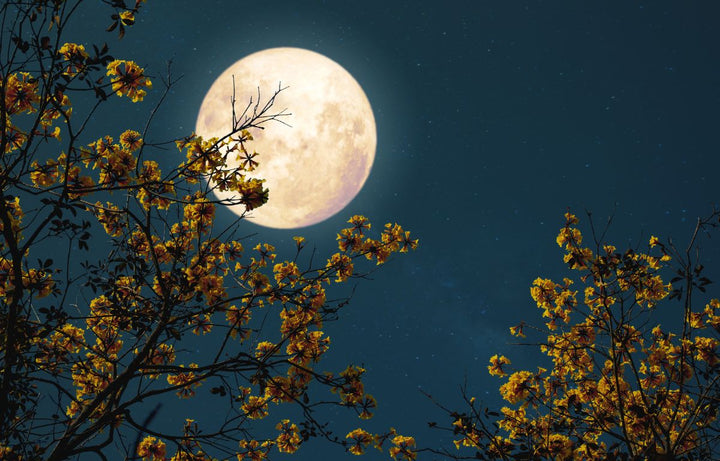
The Science and Myth of Moon Gardening: Separating Fact from Fiction
The Science and Myth of Moon Gardening: Separating Fact from Fiction
The influence of the moon's phases on plant behaviour is a topic of interest in gardening and agriculture, and it has been a subject of folklore and traditional wisdom for centuries. This belief is often referred to as "lunar gardening" or "moon planting," and it suggests that the moon's phases can affect the growth and development of plants.

Despite the name, lunar gardening doesn’t require you to garden only at nighttime. It is more about aligning your gardening activities with the phases of the moon, not the time of day or night. Having said this, some avid lunar gardeners do choose to work during the night when the moon is prominent.
Moon Phases:
- A moon's phase refers to the changing appearance of the Moon in the sky as it orbits Earth, transitioning between eight distinct phases, including new moon, crescent, quarter, gibbous, and full moon.
- Proponents of lunar gardening claim that different phases of the moon and astrological alignments affect various aspects of plant growth, such as germination, root development, leaf growth, and flowering or fruiting.
- Lunar gardening typically focuses on the gravitational pull during the moon's phases, particularly the waxing and waning phases along with varying light levels.
- It is also believed that plants absorb more water and nutrients during a full moon.
Limited Scientific Evidence:
- While some studies have explored the potential influence of lunar phases on plant behaviour, the results have been inconclusive and often contradictory.
- Scientific research on this topic is limited, and there is no widely accepted scientific consensus that the moon's phases significantly impact plant growth.
- Lunar gardening finds support in anecdotal evidence, comprising personal observations, historical practices, and cultural knowledge. Gardeners who practice it often report noticing differences in plant growth and health based on lunar phases.
Civilisations and cultures:
- Evidence supports that lunar gardening was practised by Ancient Egyptian, traditional Chinese, old European traditions and Native North American cultures.
- The lunar calendars were vital for planning agricultural activities and believed that the moon's phases had an influence on crop growth depending on when planting, weeding, and harvesting began and ended.
- While this evidence is subjective, it has been passed down through generations and plays a significant role in the belief in lunar gardening's effectiveness, despite limited scientific validation. Ultimately, its adoption depends on personal beliefs and cultural traditions.

Other Factors and Considerations:
- Today we widely know that plant growth is influenced by a wide range of factors, including genetic makeup, adaptations, soil quality, temperature, humidity, sunlight, fertilisation, and water availability.
- These environmental factors have a more reliable and substantial scientific impact on plant behaviour than can be predicted through lunar phases.
- If you're curious about lunar gardening, you can experiment with it in your own garden to see if you notice any differences in plant performance.
- Keep detailed records and observe whether there are any patterns related to the moon's phases. However, be aware that any observed effects may be due to other factors.
Here are some types of plants that are often associated with lunar gardening:
- Root Crops: Lunar gardening proponents often suggest that root crops, such as carrots, beets, and potatoes, should be planted during the waning moon (from full moon to new moon). It is believed that the decreasing moonlight during this phase promotes root development.
- Leafy Greens: Leafy greens like lettuce, spinach, and kale are sometimes recommended for planting during the first quarter moon (waxing moon). This phase is thought to encourage lush leaf growth.
- Fruit-Bearing Plants: Some lunar gardeners propose planting fruit-bearing plants, including tomatoes, peppers, citruses, and berries during the waxing moon to promote fruit development. Others may recommend planting during a specific moon sign, such as when the moon is in a fire sign (Aries, Leo, or Sagittarius).
- Herbs: Lunar gardening can also apply to herbs. For instance, planting herbs known for their strong scents, like basil or mint, during a waxing moon phase might be suggested.
- Flowers: Lunar gardening can extend to flowering plants as well. Some gardeners believe that planting flowers during specific moon phases or signs can influence bloom size and abundance.
Although modern gardening practices primarily focus on well-established principles such as soil quality, proper watering, and appropriate plant care, there are some biodynamic supporters who still use moon phases and astrological signs for agricultural planting. If you choose to incorporate lunar gardening into your practices, do so with an open mind and a willingness to experiment, but also be aware that its effects may be subtle or even non-existent.
